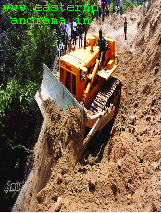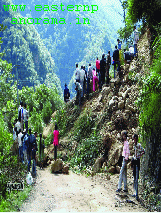Archives
ALL ROADS LEAD TO WOE Barak Valley’s problematic surface connectivity
It is really a matter of concern that though the Ministry of Highways and Roads has sanctioned Rs. 140 crore for the improvement of NH 44, no repair or improvement work has been undertaken by the PWD. It was just three months ago that the powerful and flamboyant minister of Assam Gautom Roy faced with a strong protest rally of the aggrieved people of Katigorah block in Cachar had promised effective stress on improvement within a month. His assurance seems to have been made for keeping them in good humour.
 Although a 120 mt long tunnel at a cost of Rs. 117 crore was constructed by BRTF in 2008 at Sonapur identified as a highly active landslide prone zone in order to assure the safe passage of vehicles during the monsoons, questions have been raised in competent circles about its very utility. The Sonapur area’s reputation of being a troubled zone has not changed much over time and this has further endangered commuters on this highway. According to the Geological Survey of India, the area in question is in a sort of tectonic movement which is responsible for destabilizing the entire Sonapur zone. The tunnel is just 110 mt long, leaving a large portion of the disturbed zone exposed to the vagaries of nature.
Although a 120 mt long tunnel at a cost of Rs. 117 crore was constructed by BRTF in 2008 at Sonapur identified as a highly active landslide prone zone in order to assure the safe passage of vehicles during the monsoons, questions have been raised in competent circles about its very utility. The Sonapur area’s reputation of being a troubled zone has not changed much over time and this has further endangered commuters on this highway. According to the Geological Survey of India, the area in question is in a sort of tectonic movement which is responsible for destabilizing the entire Sonapur zone. The tunnel is just 110 mt long, leaving a large portion of the disturbed zone exposed to the vagaries of nature.
In view of this, the BRTF had earlier planned to construct an alternative route to by pass the disturbed area. According to the plan, it was decided to divert the highway and run it through a bridge over Lubha river and then through tunneling ensure all weather movement for vehicles. The record maintained by BRTF shows that on an average, 2000 vehicles of all sorts move through this highway daily, making it one of the highly congested lifelines of supply for Barak Valley and three states in question. But, with political lobbying by the ruling politicians of this valley, the tunnel came up at Sonapur and state PWD took over the maintenance of the highway.
From all indications it is back to square one. The traveling public can now only shudder to think of the shape of the highway in the Assam zone after being taken over by PWD. It is to be recalled that the Sonapur zone has been the scene of many fatal road mishaps. A Mizoram state transport corporation bus and two loaded trucks from Shillong had a miraculous escape. Before the vehicles slid in slush and mud, the passengers and drivers managed to disembark from the vehicles. The most tragic of these mishaps was the death of seven people traveling in a bus which in torrential rain skid and rolled down to the meandering Lubha river. In recent times, on December 18, 2009, eight passengers of an overloaded bus operating under Tripura State Road Transport Corporation were killed when this bus plunged into the Lubha river. Yet another tragedy took place on January 6 of this year when a private car with three passengers including the driver veered off the highway and fell in the deep gorge,finally coming to a rest 400 ft down.
the highway in the Assam zone after being taken over by PWD. It is to be recalled that the Sonapur zone has been the scene of many fatal road mishaps. A Mizoram state transport corporation bus and two loaded trucks from Shillong had a miraculous escape. Before the vehicles slid in slush and mud, the passengers and drivers managed to disembark from the vehicles. The most tragic of these mishaps was the death of seven people traveling in a bus which in torrential rain skid and rolled down to the meandering Lubha river. In recent times, on December 18, 2009, eight passengers of an overloaded bus operating under Tripura State Road Transport Corporation were killed when this bus plunged into the Lubha river. Yet another tragedy took place on January 6 of this year when a private car with three passengers including the driver veered off the highway and fell in the deep gorge,finally coming to a rest 400 ft down.
As the realignment of NH 44 as the best option and as planned by BRTF did not take place due mainly to political expediency, commuters of Barak Valley, Mizoram, Tripura and East Manipur have been pressing for reviving the Silchar – Haflong – Guwahati road as an alternative route. But the utter deplorable condition of the stretch of the PWD road extending from Bandarkhal on Cachar border to Diyungmukh, opposite Karbi Anglong, in the Dima Hasao district earlier known as the North Cachar Hills have become a major stumbling block. Another raging demand has been for the revival of the abandoned Harangajao – Neille road which will reduce the distance between Silchar and Guwahati by 65 km. Again the question is of improving this road which is in a shambles.
Unless the social, business, student and youth bodies along with commuters in general of Barak Valley, Mizoram, Tripura and East Manipur join hands and start a mass movement on the issue, neither the Centre nor the states concerned will make a move notwithstanding all the sound and fury about development packages for the North East in order to quicken the growth of the economy in the region. This is the only way by which the Doner Ministry and the North East Council could be made to understand the ground reality and give proper attention not only for allotment of funds for connectivity but also for the proper implementation of these funds. The Ministry of Highways and Roads has also a major role to play in developing and improving the surface connectivity.
Jyoti Lal Chowdhury

